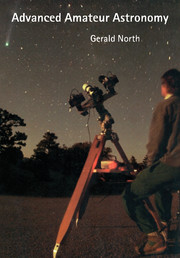Book contents
- Frontmatter
- Contents
- Preface to the second edition
- Preface to the first edition
- Acknowledgements
- 1 Telescope optics
- 2 Atmosphere, seeing, magnification and eyepieces
- 3 Telescope hardware and adjustments
- 4 Astrophotography with the camera
- 5 Astrophotography through the telescope
- 6 Electronic imaging
- 7 The Moon
- 8 The terrestrial planets
- 9 The gas-giant planets
- 10 Asteroids, comets, meteors and aurorae
- 11 The Sun
- 12 Variable stars and novae
- 13 Methods of photometry
- 14 Double stars, star clusters, nebulae, galaxies and supernovae
- 15 Spectroscopy
- 16 Radio astronomy
- 17 Further information
- Appendix: Useful formulae
- Index
9 - The gas-giant planets
Published online by Cambridge University Press: 04 August 2010
- Frontmatter
- Contents
- Preface to the second edition
- Preface to the first edition
- Acknowledgements
- 1 Telescope optics
- 2 Atmosphere, seeing, magnification and eyepieces
- 3 Telescope hardware and adjustments
- 4 Astrophotography with the camera
- 5 Astrophotography through the telescope
- 6 Electronic imaging
- 7 The Moon
- 8 The terrestrial planets
- 9 The gas-giant planets
- 10 Asteroids, comets, meteors and aurorae
- 11 The Sun
- 12 Variable stars and novae
- 13 Methods of photometry
- 14 Double stars, star clusters, nebulae, galaxies and supernovae
- 15 Spectroscopy
- 16 Radio astronomy
- 17 Further information
- Appendix: Useful formulae
- Index
Summary
Out beyond the terrestrial planets and the asteriods, the gas-giant planets are the dominant bodies of the Solar System. As is the case for Venus, we can never see the surfaces of Jupiter, Saturn, Uranus and Neptune. We see just the upper layers of their atmospheres. Consequently, most of our observations of these worlds are concerned with their atmospheric phenomena.
Observing Jupiter
Jupiter is the easiest target for planetary observation. It is also one of the most fascinating. Orbiting the Sun at a distance of 778 million km, its vast globe spans 49 arcseconds at opposition. At such times a magnification of about ×40 will show the planet through the telescope as large as the full Moon looks when seen with the unaided eye. Even at conjuction the disc still spans 32 arcseconds, when a power of ×62 will enlarge it to the same extent as before. Moreover, the planet comes into opposition every 13 months and it is observable somewhere in the sky virtually all year round, apart from a month or two near the time of conjunction.
Nomenclature
Jupiter is a planet in turmoil. Even more exciting, from the point of view of the amateur astronomer, small telescopes show abundant detail. A 6-inch or 8-inch (152 mm or 203 mm) reflector is adequate for the serious study of the planet, anything larger being a bonus. As always with planetary observation, instrumental quality is to be preferred over sheer size.
- Type
- Chapter
- Information
- Advanced Amateur Astronomy , pp. 201 - 220Publisher: Cambridge University PressPrint publication year: 1997



